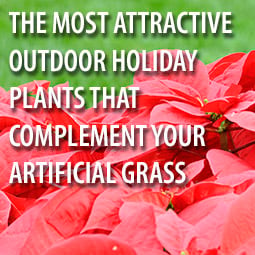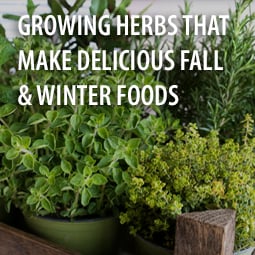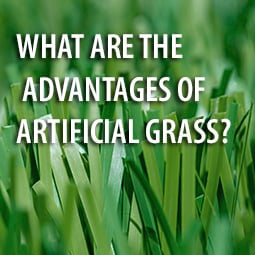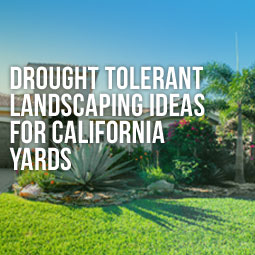 After years of severe drought, California residents are now used to dealing with water restrictions. Recently-enacted new state laws make those restrictions permanent and call for even stricter limits in the future. Wasting water is not only out of fashion, it’s beyond our budgets. So we’ve been forced to rethink our relationship with water, including how we sustain our landscaping.
After years of severe drought, California residents are now used to dealing with water restrictions. Recently-enacted new state laws make those restrictions permanent and call for even stricter limits in the future. Wasting water is not only out of fashion, it’s beyond our budgets. So we’ve been forced to rethink our relationship with water, including how we sustain our landscaping.
This is not really much of a sacrifice, because you can still achieve whatever look you want – you simply have to approach planning and growing a bit differently. Landscaping in low-water conditions gives you a multitude of options. Whether you call them “drought tolerant” or “drought resistant,” there are hundreds of plants appropriate for a water-stingy yard. You’ll find them in every category:
- Trees
- Shrubs
- Perennials
- Annuals
- Succulents and cacti
- Grasses
- Groundcovers
What about a lawn?
A pristine lawn is a thing of beauty. It provides a counter-point to the rest of your landscaping, both plants and hardscapes. If you have kids or a dog, lawn is a virtual necessity for outdoor play. You can still have a lawn, even in the driest conditions, thanks to artificial grass. You get all the benefits, without water, chemicals, or hassles. You can extend those benefits by using artificial grass for walkways, or even a backyard putting green.
Take a holistic approach
You have to comply with water regulations, or face a stiff fine (not to mention glares from your neighbors). That means using less water, but you can also be smarter about how you use it. Along with choosing the right plants, you can personalize your space with permeable hardscape materials, decorative objects, and construction and gardening techniques that retain natural moisture and rainfall.
There’s no need to be depressed, or distressed. Drought tolerant landscaping does not sentence you to a yard that is ugly or no fun to use. It is an invitation to get creative, and the result can be supremely beautiful, functionally practical, beneficial for the environment, and a lot less work and expense. Nice.
Read on to get more ideas on creating a landscape that thrives with little water.
Drought Tolerant Landscaping Design
Don’t get out yo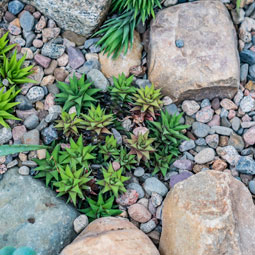 ur shovel or head to the nursery quite yet. By taking time to learn some basic principles and best practices used by landscape design professionals, your own design will look amazing and serve you well.
ur shovel or head to the nursery quite yet. By taking time to learn some basic principles and best practices used by landscape design professionals, your own design will look amazing and serve you well.
- Start with the big picture. In front, the yard should complement your home or provide an eye-catching contrast to it. In back, your outdoor lifestyle takes precedence. Do you have kids, or a dog? Your patio, pool, outdoor kitchen, and veggie garden are all elements that form the foundation of your design. The plants you choose can separate as well as decorate each of these “rooms.”
- Elevation changes create an overall harmony. Think about tall trees, mid-size shrubs, smaller perennials, and low-growing groundcovers. Use taller plantings to create walls or screens that provide privacy or just a comforting sense of enclosure. If your yard is flat, use large boulders or build low mounts to add interest to your terrain. If your yard slopes, use tiers and wide steps.
- If your space is small, incorporate vertical gardening.
- Create a few focal points to lead the eye around your garden. Focal points can be a statue or a birdbath, an interesting rock, an unusual flowering tree, or a block of bold color.
- Pick plants based on their mature size, and plan accordingly. Giving them room now saves you time and headaches later.
Now that you have the basics in mind, let’s look at how you can transform your vision into a water-wise reality.
What's the Best Time of Year to Install Artificial Grass?
Since artificial grass is the plant kingdom’s poster child for “drought resistance,” chances are good that you’ll want at least some lawn in your landscape. But is there a specific time of year that’s best for installation?
Nope. Fake grass is happy to accommodate whatever schedule works best for you. That said, we’ve noticed there are a couple of times home owners seem to prefer. Here’s why:
- Early spring installation puts artificial grass in your yard and under your feet right from the beginning of your outdoor living season. How clever of you to deftly avoid that dreaded “spring cleaning” your natural lawn always requires. You can kiss that goodbye forever.
- Early fall installation is also a good time. Your outdoor activities are coming to a close for the season, and your natural grass is slowing down, too. Get rid of it now, and you’ll have gorgeous, vibrant grass to admire all winter. And when spring arrives, you’ll be ready to play.
Artificial grass can even improve your indoor landscape, providing far more comfortable flooring for your basement or sun room than concrete or carpet. It’s fluffy, fun, and never absorbs dampness. And just like outdoors, you can install it any time you like.
Why wait? The sooner you get your artificial grass in place, the sooner you can start to build out the rest of your drought tolerant landscape plan.
Drought Tolerant Landscaping Ideas
You’re armed with a list of landscape design principles, and your artificial grass is in place – or at least drawn in place on your landscape plan. Now what? The possibilities are almost endless. Let’s start with some general ideas for transforming your property into a pleasing, purposeful space.
Location is everything
Landscaping ties your entire property together, no matter the size of your yard or how you use it. Did you decide to jettison lawn in your front yard? Lots of home owners are doing that now, leaving grass for their backyard, where it can both create and accentuate outdoor living areas. That’s artificial grass, of course. After all, your goal is miniscule water usage, right?
In front, no-lawn landscaping provides a setting for your home. You can use plantings and hardscape elements to emphasize angular, ultra-modern architecture or soften it. You can go minimalist or fill the space with fluffy, colorful vegetation. Yep, there are drought resistant plants for that. (Keep reading.)
Aside from choosing an overall look for front vs. back yards, you’ll want to consider the setting. How much sun or shade do your spaces receive, and at what time of day? “Right plant, right place” means matching plants with their favorite comfort zones, so they can thrive beautifully with little water or maintenance. There are drought tolerant plants for every conceivable setting.
Beyond plants
It takes more than trees, shrubs, and smaller plants to create a really great landscape. Consider how you can use geometric or curving pathways, dry “rivers” of smooth stones, found objects, or a tiny “watering hole” for butterflies to add practicality and visual interest.
Sustainable Landscaping
Your landscape can d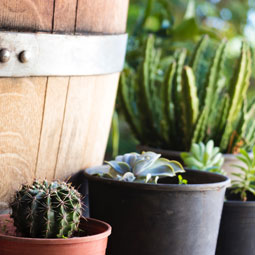 o more than reduce household water usage, if you consider the broader issue of sustainability. Plants and hardscape materials help you conserve multiple natural resources, and deliberately support environmental diversity.
o more than reduce household water usage, if you consider the broader issue of sustainability. Plants and hardscape materials help you conserve multiple natural resources, and deliberately support environmental diversity.
For example, don’t plant something that will get big in a space that’s too small. This common mistake leads to repeated pruning, which leads to unnecessary yard waste in our landfills. Do choose natural insect controls and organic fertilizers, if you use any at all.
Create an environment conducive to wild things as well as your family
Native plants are acclimated to our weather conditions, so they are naturally drought tolerant. They are also favorites of bees, butterflies, and other pollinators as well as birds, who eat bugs and small fruits.
By selecting the right plant varieties of native and non-native plants, you can invite a wide variety of these small beauties into your yard, to feed, rest, and reproduce. And you get to sit back and watch the show.
REPURPOSE ITEMS AND CHOOSE RECYCLED MATERIALS
“Found” items from around the house, thrift shops, and flea markets make great garden containers, yard ornaments, and outdoor furniture. Permeable pavers, crushed rock, and recycled concrete allow you to build practical-use landscape elements and support the environment, too.
Isn’t it nice to know that your landscaping plan can be both water-wise and proactively eco-friendly?
Drought Resistant Plants for Your Perimeter
If you’ve chosen artificial grass to create a lawn or a backyard putting green as part of your landscaping plan, drought resistant plants are ideal to surround and complement those spaces with color and texture. Since your grass is very low, you can go up, up, up with your planting plan.
To choose the perfect plants, consider their:
- Height and width at maturity
- Leaf color, shape, and size
- Bloom time and color, if any
- Fall and winter interest – evergreen, eye-catching bark or structure when leaves are gone, fall colors or berries, etc.
Your yard has multiple “perimeters”
Larger trees and shrubs combine with wooden fences or low stone walls to mark the perimeter of your property. They provide privacy, protection from wind or hot afternoon sun, and create a living foundation for the rest of your garden and outdoor living areas.
Many of us here in the South Bay Area have pools. Nothing offsets your pool like pretty flowering plants around the perimeter. There are drought tolerant varieties which are also pool-friendly because they don’t shed lots of leaves or other debris. What else is ideal to surround your pool? Faux grass. It’s a major improvement over traditional decking in every way.
Containers are nice for perimeters, too. Use several in series to create a very low “wall,” or just one as an accent. Grow veggies or herbs as well as flowers.
Drought Tolerant Grass Solutions
Just because you’ve jettisoned your water-hogging live lawn doesn’t mean you can’t have grass. We’ve discussed the many ways artificial grass can grace your yard, but there is another type of grass you should also consider, especially for a drought tolerant landscape. We’re talking about ornamental grasses.
These beauties can solve many landscaping challenges, but you may well want them simply for their stylish good looks. Why?
- They come in just the right size for your space, big or small. For example, Elijah Blue fescue is a bluish gray variety with very fine leaves. It grows no taller than a foot. Love that blue color but want something in the 2-3 foot range? Blue oat grass is for you. For warm, rusty-red color, go with leatherleaf sedge. Miscanthus can be a stunning focal point or grouped as a living hedge, getting as tall as 4-6 feet when it blooms.
- Different varieties have feathery flower plumes or striped leaves. Leave them in place for a striking winter impact, then cut them down in spring so they can grow right back.
- No matter what type of hardscapes you have – decorative or purely practical -- grasses soften their appearance.
Grasses are so versatile, you could design your entire landscape around them. But they make excellent companions for other types of trees, shrubs, and flowers.
Drought Tolerant Bushes
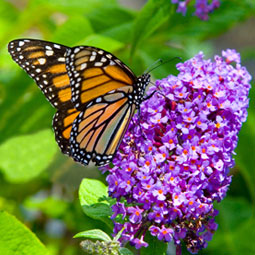 Call them bushes, or call them shrubs, every drought tolerant landscape needs some mid-size plantings. Yet again, your biggest challenge will be choosing from the numerous options. Depending on where your home is situated, you might want to consider varieties that are wildfire resistant as well as drought resistant.
Call them bushes, or call them shrubs, every drought tolerant landscape needs some mid-size plantings. Yet again, your biggest challenge will be choosing from the numerous options. Depending on where your home is situated, you might want to consider varieties that are wildfire resistant as well as drought resistant.
Shrubs lead the eye downward from trees or tall structures on your property. Since shrubs can be anywhere from a couple of feet high to 6-8 feet at maturity, you can use them to edge your lawn, create a privacy screen for your pool or hot tub, or separate outdoor living spaces within your yard.
Drought tolerant shrubs also come in an amazing array of shapes and leaf and flower colors. Many are evergreen. And many that aren’t are as eye-catching in fall and winter as they are in summer. Not only that, shrubs provide critical protection and nesting spots for several types of birds. Set out a birdbath, and you’ll be a happy at-home bird watcher.
Some good choices?
- Beautyberry
- Boxwood
- Butterfly bush
- Forsythia
- Holly
- Panicle hydrangea
- Rosemary
- Russian sage
Want something mid-size but not the usual “bush”? Consider larger succulents such as aloes or agaves. They can be spectacular, especially when they send up their gorgeous flower stalks.
Drought Tolerant Vegetables for Your Garden
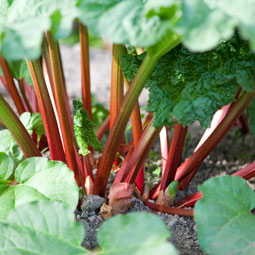 Never thought you’d use “drought tolerant” and “veggies” in the same sentence? We have news for you – good news! Lots of popular vegetables are surprisingly water-miserly. Your landscape plan can be the soul of sustainability and a culinary masterpiece, too. Yum. And if you have kids, planting veggies can be a wonderful way to introduce them to the joys of gardening as well as get them to eat their vegetables.
Never thought you’d use “drought tolerant” and “veggies” in the same sentence? We have news for you – good news! Lots of popular vegetables are surprisingly water-miserly. Your landscape plan can be the soul of sustainability and a culinary masterpiece, too. Yum. And if you have kids, planting veggies can be a wonderful way to introduce them to the joys of gardening as well as get them to eat their vegetables.
Here is a sampling of veggies that are low on thirst but high in flavor:
- Artichokes
- Asparagus
- Beans
- Blue corn
- Eggplant
- Melons
- Mustard greens
- Okra
- Rhubarb
- Onions and garlic
- Summer and winter squash (including pumpkins)
- Sweet and hot peppers
- Tomatoes
To conserve water, choose varieties with smaller fruits and shorter growing seasons. To conserve space, grow vining and twining veggies on trellises. If you choose the right varieties, you can even extend your veggie garden’s productivity into fall or winter.
Don’t neglect herbs
The woody varieties such as culinary sage, rosemary, and thyme are gorgeous additions to any garden and culinary staples as well. All three come in a variety of sizes, leaf or flower colors, and fragrances. And most of them are evergreen here in the Bay Area.
CONCLUSION
As Californians, we know we will always face drought -- or the threat of drought – as we move into the future. But we’re tough, and we’re creative. And we care deeply about our environment. So we’ve embraced drought tolerant gardening as the new normal.
If you’ve read this far, you’re now well aware that there is nothing restrictive about drought tolerant landscaping. You can design whatever you want, no matter the size or shape of your space, no matter your aesthetic or functional goals.
With so many choices, it is easy to feel overwhelmed. We’ve offered lots of ideas, and you need only look online to find a wealth of additional ideas. You may also want to learn about are the latest trends in garden design.
Plan with care, but be flexible. Your tastes may change, or the way you use your outdoor spaces may change, but your landscaping can evolve right along with you.




